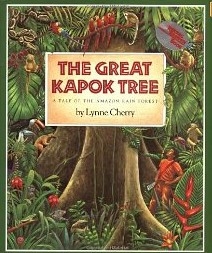Search for Resources
Description
According to Publisher's Weekly, this book combines illustrations that reveal a naturalist's reverence for beauty with a myth-like story that explains the ecological importance of saving the rain forests. The text is not a didactic treatise, but a simply told story about a man who falls asleep while chopping down a kapok tree. The forest's inhabitants--snakes, butterflies, a jaguar, and finally a child--each whisper in his ear about the terrible consequences of living in "a world without trees" or beauty, about the interconnectedness of all living things. When the man awakens and sees all the extraordinary creatures around him, he leaves his ax and "walks out of the rain forest." A map showing the earth's endangered forests and the creatures that dwell within ends the book which, like the rain forests themselves, is "wondrous and rare."
General Assessment
Recommendation of how and where to use it
This book could be incorporated into a study on habitats. Teachers may bring drama and art as a companion and encourage students to explore and act out the different types of animals. Students could assume the character of the animal and also write letters to the man who fell asleep in the rainforest, asking him to respect their habitat.
Relevant Curriculum Units
The following tool will allow you to explore the relevant curriculum matches for this resource. To start, select a province listed below.
- Step 1Select a province
- Alberta
- Step 2Select a grade level
- Grade 3
- Step 3Select a subject
- Science
- Step 4Relevant matches
- Living Systems: Understandings of the living world, Earth, and space are deepened through investigating natural systems and their interactions
- Grade 4
- Step 3Select a subject
- Science
- Step 4Relevant matches
- Exploring connections strengthens our understandings of relationships to help us make meaning of the world.
- British Columbia
- Step 2Select a grade level
- Grade 2
- Step 3Select a subject
- Science
- Step 4Relevant matches
- Science 2: Living things have life cycles adapted to their environment
- Grade 3
- Step 3Select a subject
- Science
- Step 4Relevant matches
- Science 3: Living things are diverse, can be grouped, and interact in their ecosystems
- Grade 4
- Step 3Select a subject
- Science
- Step 4Relevant matches
- Science 4: All living things sense and respond to their environment
- Manitoba
- New Brunswick
- Newfoundland & Labrador
- Northwest Territories
- Nova Scotia
- Nunavut
- Ontario
- Step 2Select a grade level
- Grade 4
- Step 3Select a subject
- Science & Technology
- Step 4Relevant matches
- Life Systems: Habitats and Communities
- Prince Edward Island
- Quebec
- Step 2Select a grade level
- Grade 2
- Step 3Select a subject
- Science & Technology
- Step 4Relevant matches
- Living things
- Grade 3
- Step 3Select a subject
- Science & Technology
- Step 4Relevant matches
- Living Things
- Grade 4
- Step 3Select a subject
- Science & Technology
- Step 4Relevant matches
- Living Things
- Saskatchewan
- Yukon Territory
- Step 2Select a grade level
- Grade 2
- Step 3Select a subject
- Science
- Step 4Relevant matches
- Science 2: Living things have life cycles adapted to their environment
- Grade 3
- Step 3Select a subject
- Science
- Step 4Relevant matches
- Science 3: Living things are diverse, can be grouped, and interact in their ecosystems
- Grade 4
- Step 3Select a subject
- Science
- Step 4Relevant matches
- Science 4: All living things sense and respond to their environment
Themes Addressed
Citizenship (1)
- Ecological Footprint
Ecosystems (4)
- Appreciating the Natural World
- Habitat Loss
- Interdependence
- Wildlife Protection
Land Use & Natural Resources (1)
- Forests

